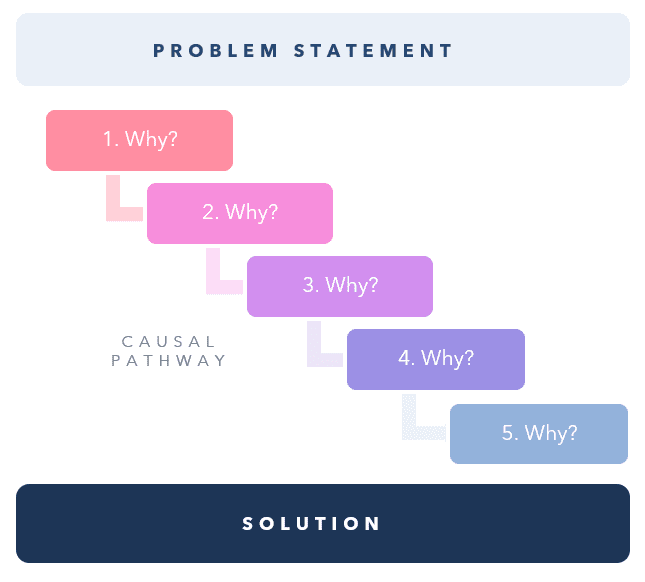The basis of Toyota’s scientific approach is to ask why five times whenever we find a problem […] By repeating “why” five times, the nature of the problem as well as its solution becomes clear.
– Taiichi Ohno
Key Takeaways
- The Fives Why process that traces its wide-adoption and popularity to Taiichi Ohno of Toyota Production System
- Using the Five Why process as an RCA technique is useful because it helps to understand that below the obvious “symptoms” of a problem there is a great catalyst
- The primary benefit of the Five Why analysis is that it serves as a simple, cost-effective tool to reveal the root of problems while preventing the reoccurrence of these problems
What is the ‘Five Why’ analysis and why use it?
The Five Why analysis traces its origin to Sakichi Toyoda of the Toyota Industries Co. It gained its reputation as a root cause technique thanks to lean manufacturing pioneer Taiichi Ohno of the related Toyota Production System (TPS). The belief was that, by diving deep into the issue, the investigator would gain more clarity into what was truly causing the problem.
Today, the Five Why analysis is a widely recognized problem-solving technique used in RCA investigations to narrow down the cause of a failure by asking ‘why did this occur?’ multiple times. By asking ‘why’ after each response, a new layer is uncovered until the true root cause of the problem is exposed and can then be rectified.
Using the Five Why analysis is effective because it understands that below the obvious symptoms of a problem there is a great catalyst. That problem can come in many forms: whether from inadequate maintenance, poor planning/scheduling, incomplete or malfunctioning sensor data, or an internal procedure that needs to be reassessed.
When using the Five Why analysis, the responses gathered through the causal pathway allow organizations to deploy long-lasting improvements that can avoid similar issues in the future.
The Five Why analysis as an RCA tool
As an RCA technique, the Five Why analysis helps to investigate an incident and diagnose the root of an issue without having to do an extensive root cause analysis. It is used proactively for investigations like near-miss incidents and non-critical equipment failures.
(Read more about RCA in our eBook ‘Four Steps to Improve Your Root Cause Analysis Program’)
The technique can be used by following these simple steps:
#1 Define the problem clearly and simply
Build a knowledgeable team with members who are involved with the specific project or equipment you are investigating. Use this team to agree on a clearly defined problem statement to get closer to the root of the issue. It is critical to agree on the definition of the problem and to focus on errors and inefficiencies within the processes.
#2 Clarify the Evidence
Outline the specifics of the problem and collect evidence from the incident. Evidence is information that is both valid and quantitative. Examples would be data logs, witness statements, instruments, physical symptoms, and observations.
Note: Do not stop at human error as this is usually the symptom of larger problems within the organization.
#3 Conduct the Five Why analysis
Once the evidence is outlined, ask the question ‘What could have caused this issue to occur?’ and record the answer with tangible evidence. An effective way to gauge whether you are focusing on the right problem is to ask whether the problem will occur again if the most recent answer to the problem is corrected or if anything else can produce the same problem. Continue with this causal pathway until you get to the root of the problem – typically this is a gap in processes within the organization.
Note: Not every case will reach the root cause at the fifth “Why” because a problem may require going deeper into the causal pathway. It is appropriate to continue until the root cause is identified.
#4 Design the right solutions for lasting process improvements
Once you reach the root cause of the issue, you can begin to design solutions that will remedy the issue.
A solution is considered appropriate if it:
- directly addresses the issue
- drevents a reoccurrence of the issue
- is controllable
- helps achieve organizational goals and objects
- does not create a ripple of more problems
With the solution in place, a detailed implementation timeline can be made with clear roles and responsibilities. This clarification ensures lasting improvements to the process with significant risk reduction.
Five Whys example
Problem Statement/Incident
A machine critical to production is leaking oil despite receiving regularly scheduled maintenance and having a new seal installed.

Infographic: ‘Five Why’ analysis flow chart
Why #1: Why is the machine leaking oil?
The seal appears to be corroded, therefore losing integrity, leading to a small leak.
Why #2: Why is the seal corroded?
There appear to be non-native particles in the oil, which could be causing damage to the integrity of the seal.
Why #3: Why are there non-native particles in the oil?
The filter that was installed during the most recent scheduled maintenance is not functioning properly and is letting through the non-native particles.
Why #4: Why is the filter not functioning properly?
The filter did not align with OEM specifications, leading to a poor fit that allowed non-native particles to permeate. These non-native particles eventually led to the seal corroding and causing a leak.
Why #5: Why was the right filter not replaced?
There is no management of change for filter changes – therefore the tech who performed the maintenance did not have all the information necessary to avoid the small mistake.
Root Cause: The true root cause is that there is no management of change for seal changes.
Actions
-
- Immediate action: Replace the filter with the OEM recommended mesh filter
- Interim action: Input corrections to the reorder specifications so that it keeps into account the proper seal and filter
- Root cause Solution: Review and address management of change deficiencies
Once these steps are complete, the incident should be closely monitored to ensure the right solution was implemented.
Benefits and challenges of the Five Why analysis
Benefits
- A simple, cost-effective tool to reveal the root of a problem while preventing reoccurrences
- Reduced occurrence of similar issues
- Easy to use as an in-house investigation tool
- Instills a culture of ownership and inquisitiveness across the organization
- Produces safer work environment with fewer call outs and reduced operating costs
Challenges
- Not all causal pathways will lead to a solution
- It may not always be possible to narrow down a single cause
- The accuracy and success of the results are dependent on human factors
- The proposed solutions must be tied to the true cause to be effective
- Follow-up and accountability are needed on action items
📰 Download free ebook: Four Steps to Improve Your Root Cause Analysis Program
Get inspired
The seven benefits and six critical success factors for a successful implementation of Autonomous Maintenance.
Discover how simple changes to your data strategy will drastically reduce maintenance costs and boost savings.
Media interview with client TenneT about the harmonization of the (onshore and offshore) asset management.





